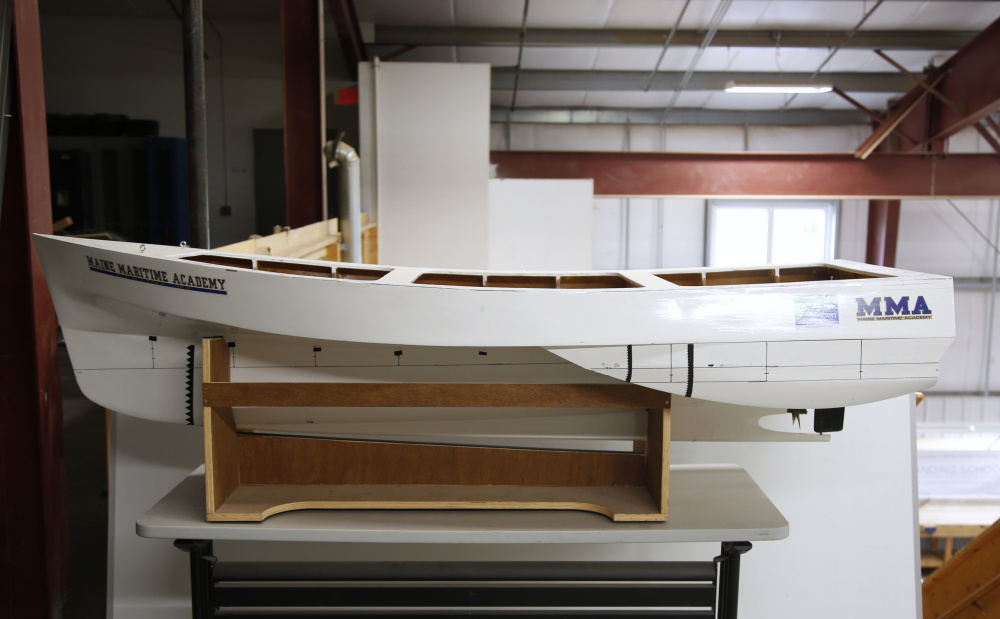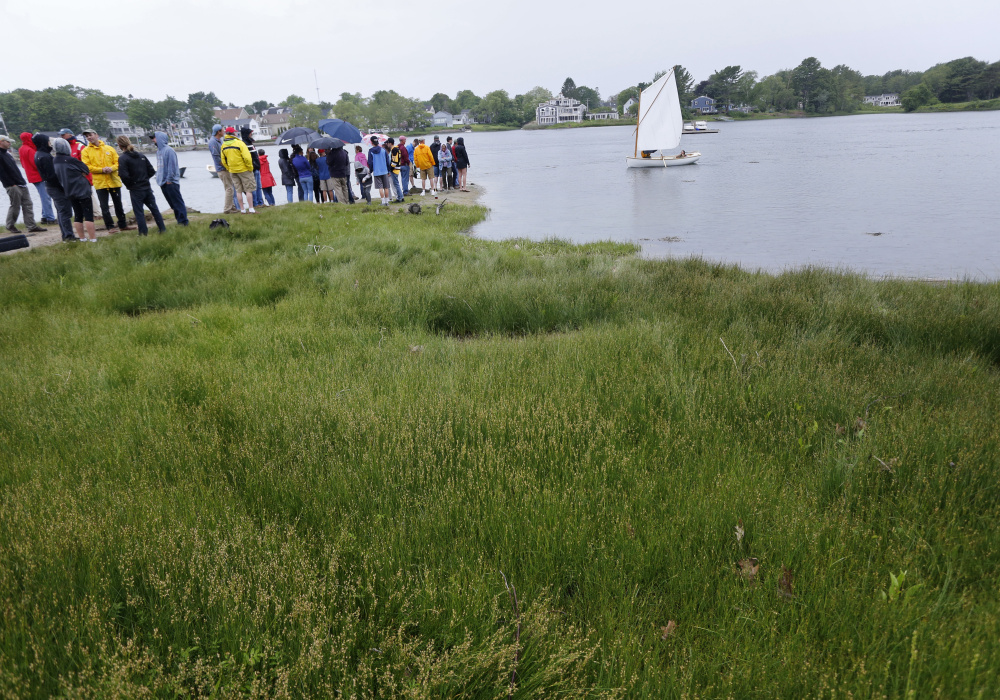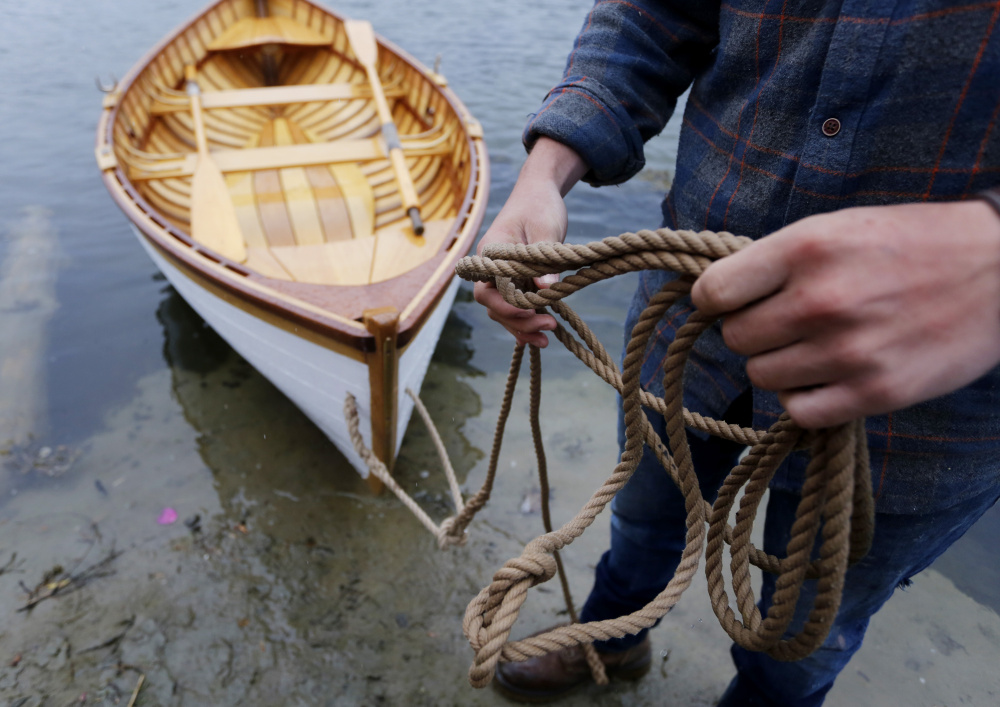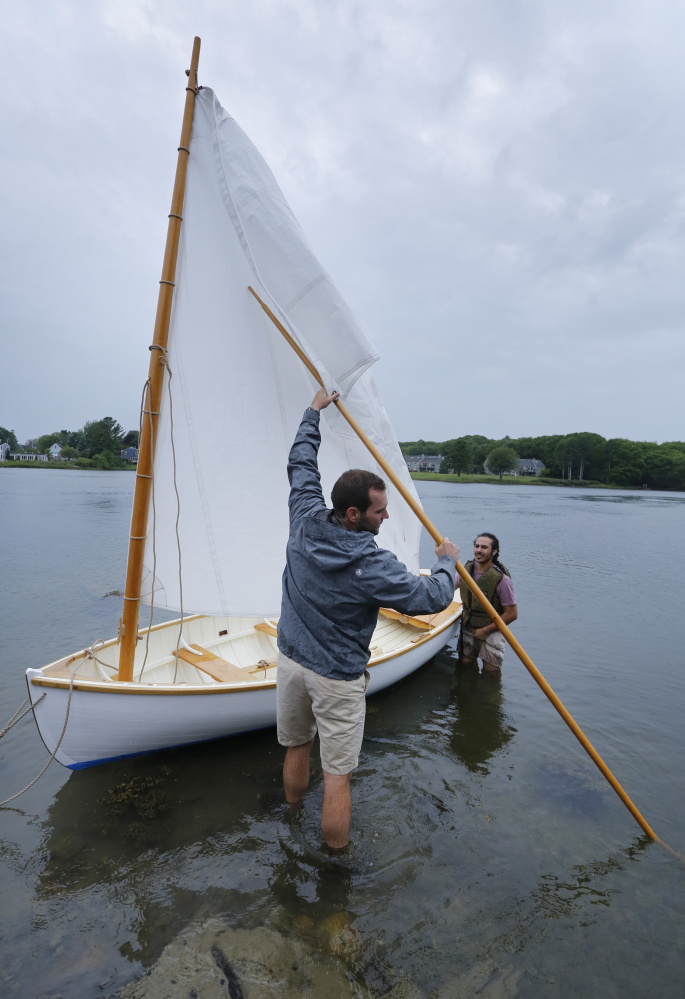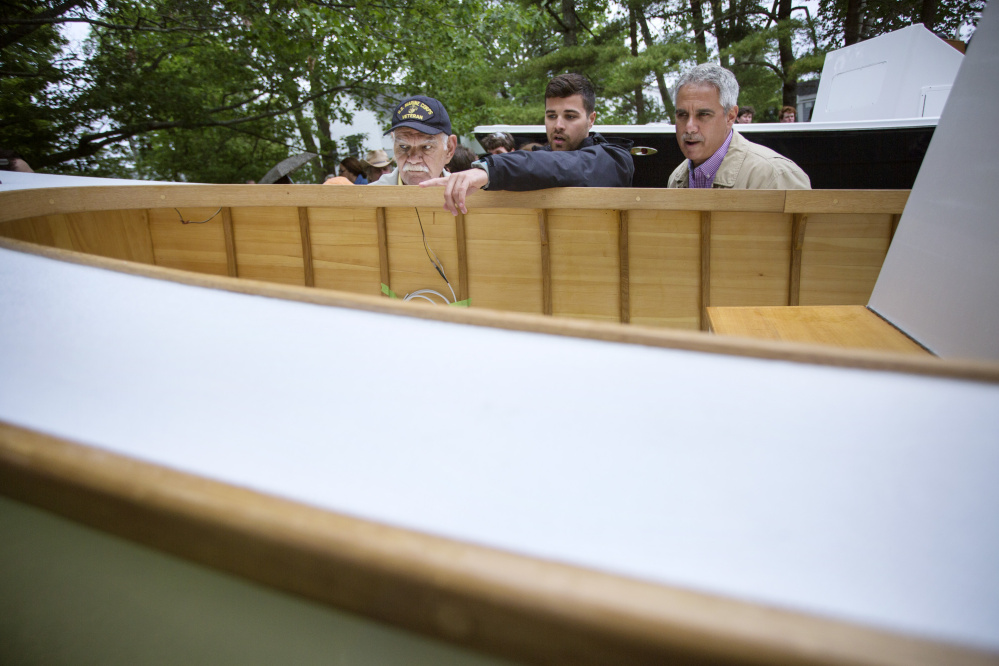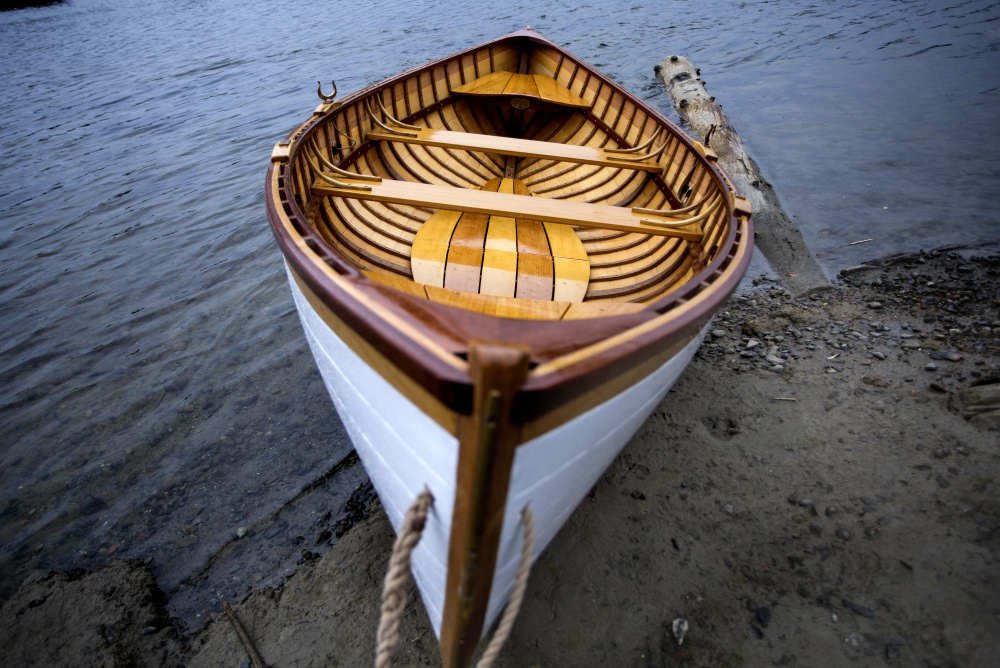ARUNDEL — Students at the Landing School have built nearly 400 boats since the school was founded in 1978. But nothing quite like the one the school is about to start on, a 21-foot, ocean-ready test model called a “proof of concept” for what the engineers call a “low-impact commercial trimaran” but which is known colloquially as a “green lobster boat.”
“It’s like a skiff on top of a canoe, with two small canoes at the back of the skiff,” said Richard Schuhmann, the president of the Landing School. “It looks like a Batmobile in a way.”
That’s the view from bow or stern. In the water and viewed from the side, it will look fairly similar to a classic lobster boat, a shape that conjures up Maine as neatly as a L.L. Bean hunting shoe and, the hope is, meets the desire expressed by many of the lobstermen consulted: that it be “pretty.”
From design to materials, this boat is intended to have a smaller carbon footprint, burning less fuel than the busy lobster boats already working in Maine’s waters.
The plan is to start working on test panels this summer, then put the arriving class of students in the fall to work on the build, with a launch date scheduled for June 2018. For now this green Batmobile exists in computer renderings and as a nearly 7-foot model that sits just outside the Landing School’s new Innovation Lab. The model was built by Doug Read, an associate professor of engineering at the Maine Maritime Academy, who designed it after many town hall style meetings with fishermen to get input about what they needed and wanted. And didn’t want. The collaborative effort to bring the green lobster boat to life, or at least, ready for a sea trial has been a long process – six years already – involving both these Maine schools and the Maine Center for Coastal Fisheries (formerly known as Penobscot East Resource Center) in Stonington, the heart of Maine’s lobster fishery.
INCEPTION
But the whole process started with a kayak ride in 2010.
A regular donor to what was then Penobscot East who summers in Brooklin had been out for paddle and noticed, as one does in a kayak, that the lobster boats passing him created a fair amount of wake. The displeasure involved with getting swamped aside, the way the boats plowed through the water struck him as not particularly energy efficient. The kayaker (who prefers not to be named) was noticing a lot of beamy lobster boats, made wider to accommodate greater numbers of traps as the fishery capitalized on the glut of lobsters. He called up Robin Alden, the executive director of the Maine Center for Coastal Fisheries, and proposed that the nonprofit, which works with fishermen to promote innovation and sustainable management approaches, work on developing a better, greener lobster boat. He’d give some seed money.
Alden was intrigued; anything that cut back on a fishery’s dependence on fossil fuels – fuel is typically one of a lobsterman’s bigger expenditures, if not the biggest – would represent a smart innovation.
Read was brought in as the consultant, designer and engineer. At that point, he’d recently joined the Maine Maritime Academy’s faculty after five years at Bath Iron Works. The lobster boat was a whole new design concept for him. “I had worked on destroyers and warships, and I didn’t know that much about small boats.”
His other role was as chief listener.
“The first step was, we had a whole lot of meetings with fishermen about this idea,” Alden said. The core question put to the gatherings was, if there were a way to design a boat that would use less fuel, would you be interested?
Alden hastens to add that lobster boats, despite that iconic, much loved shape, have evolved plenty over the decades, and successfully. They are “pretty darn good as it is,” she said. The questions put to the lobstermen were, first, what could you do to improve it? And if it were made to be more fuel efficient, would you be willing to give it a try?
Some dismissed the idea as “stupid,” Alden and Read both recall. Others were interested, with one requirement.
“The advice was, it better be pretty if you’re going to change it,” Alden said.
RESEARCH AND DEVELOPMENT
Read got the message. “You don’t want to go sticking spaceships out on the water,” he said.
But he rethought the classic monohull shape of the lobster boat. With a catamaran or a trimaran, maybe he could get more bang for the buck, fuelwise (less drag) while still maintaining a capacious deck for all those traps. Read quizzed the lobstermen about their needs. Would an electric engine be acceptable? That seemed like too big a leap. He tinkered. He got his students involved, using seniors working on their capstone projects to develop plans. He and Alden made sure to keep the fishermen involved as the plans developed, bringing materials to the annual Fisherman’s Forum to get feedback. Some people told him he was crazy.
One key piece of information gleaned from a survey at the forum was about speed. “Fourteen knots was the desired average cruising speed,” Read said. But some wanted the capacity to move a lot faster. “Some guys will just tell you, ‘I want to go 30 knots.'”
To them he’d have to say, this greener boat I’m working on is not going to be for you. “If you want to go over 20 knots, this is not it.”
He said he was pleasantly surprised by how open-minded many of them were.
“The lobstermen know how much fuel costs,” Read said. “They know speed costs them money, and they get the bottom-line piece of it.”
He and his students built a model, 6 feet long, and tested it in two tow tanks and in San Diego Harbor, where it was attached to another vessel. It went well, so they looked at the next step, building a version big enough to do real testing in, to see how it maneuvers, what the actual fuel efficiencies could be, and could it hold steady while someone was pulling a trap? Read got an enthusiastic response for the concept from commercial boatbuilders, but no one willing to make the investment in scaling up the model green lobster boat; boats aren’t cheap to build.
Then in April of 2016, he went to the University of Rhode Island’s Graduate School of Oceanography for a two-day Green Boats Workshop. Among the shipbuilders, marine architects, ocean scientists and representatives from ports, was another guy who had come down from Maine with a presentation to make: Richard Schuhmann, the president of the Landing School. Schuhmann had graduated from the Landing School, which awards both one-year diplomas and an associate degree for a two-year applied science degree in marine industry technology, in 1987. “One of the top five transformative experiences of my life,” Schuhmann said.
But he went on to get a doctorate in environmental engineering and his career had been spent in very different academic settings – teaching environmental engineering, design and leadership at Penn State University, a couple of years at the Massachusetts Institute of Technology, as well as six years exploring historic shipwrecks. When he returned to the Landing School, less than two years before the Rhode Island conference, he began working on what he saw as an essential dilemma in the boat business: the bare consideration paid to sustainability issues.
He’d built just two boats in his life at that point, the boats that students at the Landing School build as part of their degree program. But his passion for green boat building extended well beyond wanting to make sailboats, or sleek, traditional wooden vessels. He wanted to make a difference in the type of boat of that most people are buying (and thus, making). “We love sailing,” Schuhmann said. “But the reality is that 95 percent of the boats that are being sold today in the U.S. are powerboats.”
In Rhode Island, his presentation was about the Arundel 19, an outboard center console powerboat with the lines of a lobster skiff. Schuhmann had convinced the designers at the Landing School, and Richard Woodman, a teacher he’d had while at the Landing School whom he’d brought back to be the school’s instructor of Wooden Boat Building, to make a serious attempt at creating a zero carbon version of the Arundel 19. That would mean a boat that sequestered enough carbon to completely offset its typical carbon footprint, such as harvesting exotic woods and transporting them across the world to Maine, or making fiberglass, a material almost impossible to dispose of cleanly. They succeeded by using only U.S.-grown wood and pulling off a last-minute woodworking feat involving a Maine-made version of plywood, versus the typical plywood made in and shipped from the Pacific Northwest. (The Landing School also won a 2016 grant to refine a Life Cycle Assessment tool Schuhmann developed for boatbuilding, from 11th Hour Racing, a program of The Schmidt Family Foundation designed to promote collaborative systemic change in the marine world.)
Schuhmann and Read both delivered their presentations, Schuhmann’s on material selection, Read’s on naval architecture and a greener hull design. After, they got together and talked, with Schuhmann intent on persuading Read not to make the green lobsterboat entirely from carbon fiber, even though it is light and strong and thus likely to require less fuel.
“Carbon fiber is really bad for the environment,” Schuhmann said, “because it is so polluting to make.” In a Life Cycle Analysis, he said, it takes many, many miles before the benefits of using the lighter material begins to outweigh the carbon footprint cost of using it.
“You are going to have to run that boat for hundreds of thousands of miles before you dig yourself out of that pollution hole,” Schuhmann said.
He advocates mixing materials to maximize the green potential – say, making a mast out of carbon fiber and the rest of a boat from other materials, be it wood or a fiberglass-like material made using burlap (the Landing School is experimenting with that technology). “We were focused on the materials, and Doug was focused on hydrodynamics,” Schuhmann said. It made sense to join forces.
TEAMWORK
A year later, with a $97,000 grant from the Maine Economic Improvement Fund, the Landing School is preparing to build a 21-foot version of Read’s model. This summer, Schuhmann and Woodman will start milling test panels for the boat to determine which materials will work best while creating the greenest boat. “We’re on a learning trajectory, ” Schuhmann said. “We have no feel for how this going to behave as a lobster boat.”
“Until it is out hauling traps successfully, it is just an interesting experiment,” Woodman agreed.
But a year from now, they’ll have something to put in the water come graduation day at the Landing School. Then Doug Read and his students at Maine Maritime will put it through sea trials. They’ll assess it with a fuel meter, measure the pitch and roll and most important, try it out on hauling traps. “It has got to stay on the gear,” Read said.
While they’re running those trials, they’ll give the lobstermen it’s supposed to serve a chance to get used to seeing it on the water. If it’s green and a good boat for lobstering, Robin Alden of Maine Center for Coastal Fisheries is confident it will catch on. Not every lobsterman is an early adopter, but they all want to spend less and make more.
“The issue is not that they don’t adopt new technology,” Alden said. “It is that they want to figure out if it is worth doing.”
Maine has more than 5,600 licensed lobstermen and women, and the boat won’t be for all of them, she said. Their needs for size, deck space and speed are too diverse. But some of those who were dismissive in the early stages, who thought it was a stupid idea? “Those same people are now saying, ‘This is interesting. I’d try it.'” Alden said.
Mary Pols can be contacted at 791-6456 or at:
Twitter: MaryPols
Send questions/comments to the editors.




